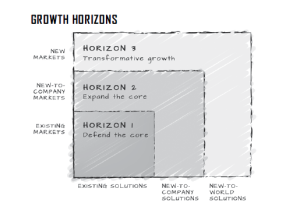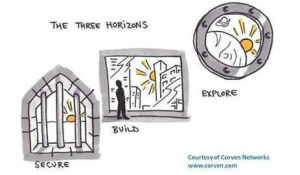 We so often struggle to articulate our innovation activity and then can’t seemingly project our plans into the future in consistent and coherent ways. We often lack the framing necessary.
We so often struggle to articulate our innovation activity and then can’t seemingly project our plans into the future in consistent and coherent ways. We often lack the framing necessary.
If this rings true of the innovation activity in your organization, then it is in danger of being seen as isolated, one-off events, that fail to link to your organizational strategy. Furthermore you’ll be missing out, or not capitalizing on emerging trends and insights where fresh growth opportunities reside.
I so often come back to the messages we need to learn, which centers around the three horizon methodology.
I just wish this framework would be adopted far more within organizations. wanting to build a sustaining dialogue around innovation, it can be such a powerful enabler.
How can we become increasingly alert to social shaping, as well as emerging technology and discoveries that might lead to new horizons and fresh growth? There is a powerful need to connect our ‘today’ with ‘possibilities’ in the future. These options, which are often only just ’emerging’, often referred too as weak signals, can be challenging as they offer both conflicts and uncertainties for our innovation future. The way to counter concerns is to build an ongoing dialogue across the organization to frame your innovation needs across the entire innovation / business portfolio.
The value of applying the Three Horizon Methodology for Innovation
Thinking in different horizons prompts you to go beyond the usual focus of fixing innovation just in the present. The Three Horizons Methodology connects the present with the desired future and identifies the ‘seen’ disruptions which might occur in moving towards a vision.
This first emerged in the late nineties through the work of Baghai, Coley and White (1999) and has been further developed by a range of practitioners such as Andrew Curry, Anthony Hodgson and Bill Sharpe (2008) and the International Futures Forum, based in Scotland. It is through the IFF group of forward thinkers I have learnt to appreciate the value of the three horizons and the way they have set about explaining their approaches and framing. One of these being this concept of seperate ‘voices’, as I recognized how well it can work within our need to think through innovation into the future.
This methodology lends itself well for mapping out the different horizons for innovation to begin to position capabilities, capacities and fill-in those needed competencies, to manage across different opportunities that emerge. It also requires a certain amount of ‘letting go’ as well as ‘embracing’ a future that still may have many uncertainties that can really challenge our established mindsets.
Its value – if well-managed – can offer a helpful way for a significant series of dialogues and tensions to surface, but through this engagement and respect for different positions you can find mutual ways of connecting your innovation activities over different horizons, and managing uncertainty in better ways as a team or organization.
The Three Horizon framework is about having strategic conversations about the future and feeds the conversation about your innovation direction and longer-term portfolio and capability understandings.
Exploring across the Three Horizons – each horizon needs a different thinking frame
We need to clarify how to identify the existing prevailing or dominant system and the challenges to its sustainability into the future, i.e. the case for change (horizon 1). Innovation can lose the ‘fit’ aspects over time as the external environment changes.
We also need to think through the desirable future state, the ideal system you desire and the emerging options. Those that can displace what you already have. Often you can find elements in the present that give you encouragement (horizon 3); keeping yourself open to all options that could lead to transformational change.
Often the struggle is to draw out the nature of the tensions and dilemmas between vision and reality, and the distinction between innovations that serve to prolong the status quo and those that serve to bring the third horizon vision closer to reality (horizon 2); This is the space of transition, often unstable, called the intermediate space where views can collide and diverge.
We work this framework in a specific sequence of H1 – H3 – H2.
There is a good reason we look at H1, then H3 and then H2 in that order. Horizon two is the toughest one, as it needs to balance between today’s existing innovation and those seen as important to the future. H2 is you transition horizon, one where you need to learn, to gather, to pilot, prototype, place limited bets and investment to learn and adjust as you work towards improving your understanding and knowledge for making the ultimate move of managing what is or shaping in horizon three.
To get there, you will adjust, pivot and constantly reshape as you learn and experiment. This is the value of this horizon 2 as you work out how the landscape is changing and requiring constant adjustments. The horizon 2 tends to work on those sustaining innovations (h2-) and those transformative innovations (h2+).
There are always plenty of uncertainties to map and resolve
Clearly it’s not acceptable to stay still and be good at what you already do and expect this to just continue out into the future. We need to consciously evolve in how to counterbalance today’s business needs with new business opportunities offered out in Horizons 2 and 3. These are providing you with a more robust innovation portfolio of options under investigation and development.
Having different perspectives will enhance your innovation activities
 The 3H framework offers a perspective that accepts the need to both address the multiple challenges that occur in the first horizon, foster the seeds of the third and, allocate appropriate focus and resources to manage the transitions from one to another. We secure, build and explore across these different horizons.
The 3H framework offers a perspective that accepts the need to both address the multiple challenges that occur in the first horizon, foster the seeds of the third and, allocate appropriate focus and resources to manage the transitions from one to another. We secure, build and explore across these different horizons.
What makes the model valuable to innovators is that it ‘accepts’ that competition is restless, markets are evolving, and that change is a constant. The three horizons approach offers the methodology for constructing plausible and coherent innovation activities projected out into the future. It looks for emerging winners.
This is not a planning tool; it is providing a valuable evolutionary perspective that dialogues can be formed around so decisions on where to focus and what resources to apply can be made on a more plausible and coherent set of activities, projected into the future, searching for emerging winners that can change and challenge your existing business.
The need is to address the challenges in horizon one and nurture the seeds of the third. It is not an either/or, good/bad discussion. You need those robust discussions to form fresh perspectives. The key is in listening out and becoming adept at managing these conversations between the ‘voices’ of the three horizons.
The three voices that need to be in the same room
The different voices involved can be highly engaged, all wanting to add their perspective:
- You have the voice of today, the incumbent, the manager(s) responsible for delivering today’s result, very much operational and result orientated, that are more concerned with managing the existing, maximizing returns and keeping the organization going efficiently and effectively.
- Then you have the second voice, the voice of the entrepreneur, the one eager to experiment, try out new things, wanting to push further, to explore and extend, accepting some aspects will not work but keen to investigate, experiment and learning from these discoveries.
- Last we have the third voice, the voice of the aspirant, who is looking to build a different vision, believing in different, more pioneering, perhaps radical solutions that seeks to visualize things in their ‘mind’s eye’, far more aspirational. This concepts often can seemingly look on first ‘take’ to be totally incompatible to the reality of today but are picking up on ‘weak signals’ that are out there that signify a changing future that might impact your own.
It is the combination of these different three voices that need to come together and frame the innovation journey by using the three horizons framework.
You really should give it a far greater consideration within your innovation toolbox, it ‘aids’ the framing of your present to future needs and gives ‘voice’ to all the different thinking and opinions on building the innovation pipeline, balancing the portfolio and helping to identify all the gaps and opportunities that need resolution.
*****
Publishing note: This blog post was originally written on behalf of Hype and with their permission I have republished it on my own site with some small adjustments. I recommend you should visit the Hype blog site where they have a range of contributors writing about a wide-ranging mix of ideas and thoughts around innovation, its well worth the visit
6 thoughts on “Drawing out the different voices within the three horizon methodology for Innovation”
Comments are closed.